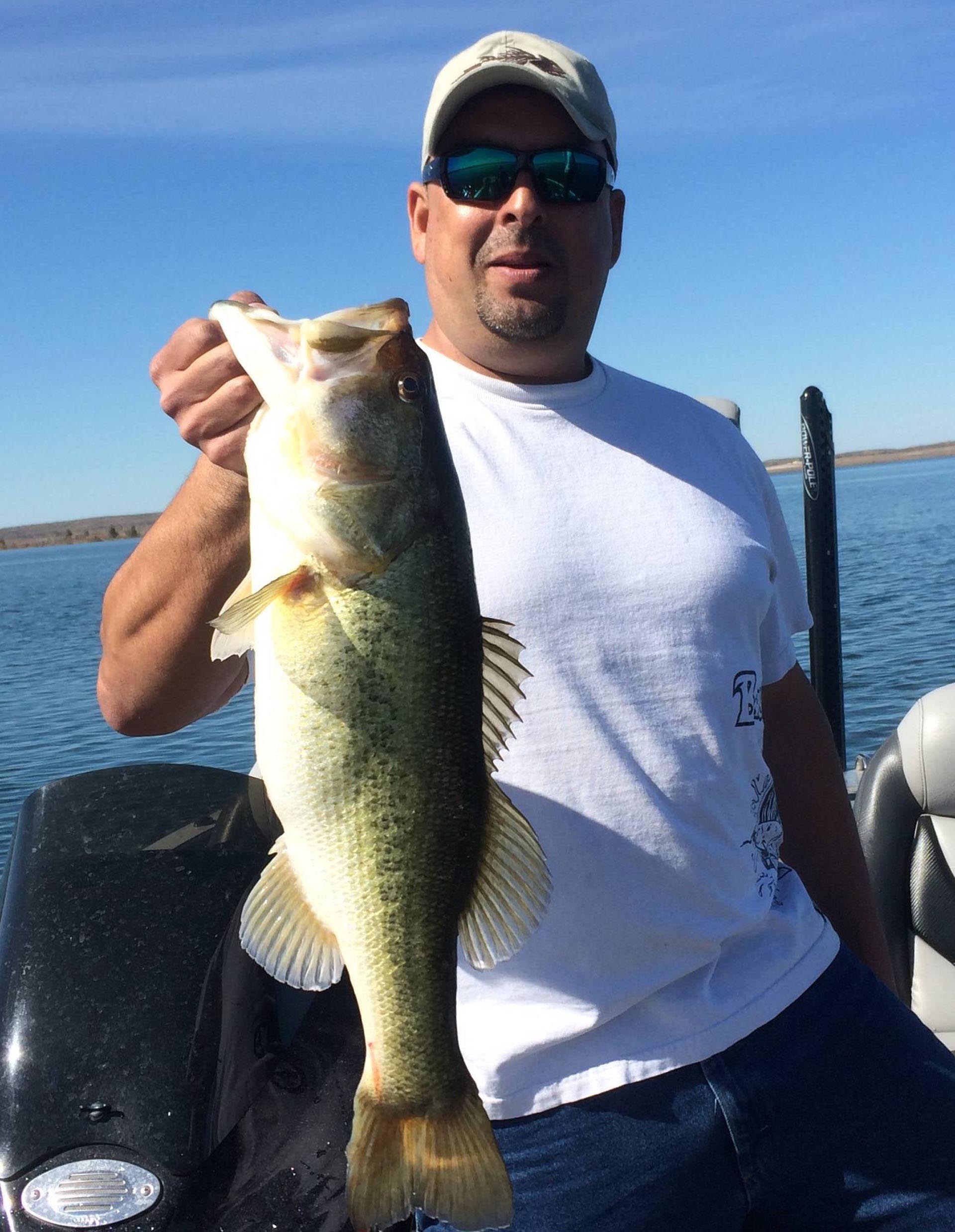Lake Amistad Bass Fishing Guide
SHARELUNKERS
This is what we are fishing for. Sharelunkers are largemouth bass over 13 pounds. There have been several caught in Lake Amistad.


ShareLunker No.502
Caught by Marion Merritt of Santa Rosa Beach, FL
April 21, 2010 in Amistad San Pedro Canyon area, 14 feet of water 13.87 pounds, length 27 inches, girth 20.13 inches Bait/Lure: 10" Berkley Power Worm Day of Week: Wed Moon Phase: 1Q Type: Pure Florida bass


ShareLunker No.497
Caught by Joseph Burgi of Del Rio, TX
April 4, 2010 in Amistad 20 feet of water at Marker 7 13.37 pounds, length 26.75 inches, girth 20.5 inches Bait/Lure: Berkley Power Worm Day of Week: Sun Moon Phase: 3Q-2 Type: Florida/northern cross Status: Died 4/20/2010
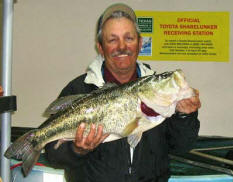

ShareLunker No. 482
Caught by Teddy Silcox of Del Rio, TX
February 27, 2010 in Amistad 28 feet of water at 52 degrees 13.02 pounds, length 27.5 inches, girth 19 inches Bait/Lure: Boudreaux bait Day of Week: Sat Moon Phase: F-1
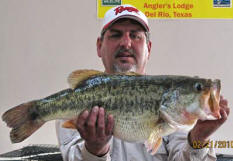

ShareLunker No. 479
Caught by Robert Robles of Del Rio, TX
February 21, 2010 in Amistad 30' of water in Evans Creek 13.5 pounds, length 25.75 inches, girth 20.5 inches Bait/Lure: Amistad Tackle Flutter Spoon Day of Week: Sun Moon Phase: 1Q Type: Florida/northern cross.


ShareLunker No. 445
Caught by Chris McEntyre of Devine, TX
March 9, 2008 in Amistad 15' of water across from 454 spur ramp 13.39 pounds, length 26 inches, girth 20 inches Bait/Lure: Perch swim bait Day of Week: Sun Moon Phase: N+2 Type: Florida/northern cross


ShareLunker No. 435
Caught by Rick Turner of Tyler, TX
March 23, 2007 in Amistad 22' of water 14.5 pounds Bait/Lure: 3/4-oz football head brown jig with a green pumpkin crayfish trailer Day of Week: Fri Moon Phase: FQ-2 Type: Pure Florida bass


ShareLunker No. 420
Caught by Travis Darley of Del Rio, TX
April 19, 2006 in Amistad 10' of water 13.58 pounds, length 27.25 inches, girth 20.25 inches Day of Week: Wed Moon Phase: LQ-2 Type: Pure Florida bass
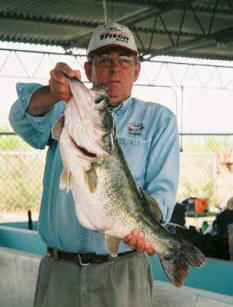

ShareLunker No. 412
Caught by Wayne Lindgren of Minneapolis, MN
March 28, 2006 in Amistad San Pedro Canyon, off brush, 5' of water 13.18 pounds, length 26.5 inches, girth 20.75 inches Bait/Lure: wacky-rigged Senko worm Day of Week: Tue Moon Phase: N-1


ShareLunker No. 400
Caught by Jason Baird of Gypsum, KS
February 28, 2006 in Amistad Castle Canyon area 13.1 pounds, length 26 inches, girth 21 inches Bait/Lure: Smallie Beaver creature bait Day of Week: Tue Moon Phase: N Type: Pure Florida bass
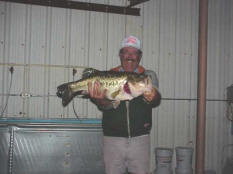

ShareLunker No. 307
Caught by Thomas Kish of Del Rio, TX
February 24, 2000 in Amistad 4' of water 13.05 pounds, length 26 inches, girth 19 inches Bait/Lure: brush hog Day of Week: Mon Moon Phase: LQ-3


ShareLunker No. 58
Caught by Lendall Pervatt of Del Rio, TX
March 3, 1990 in Amistad 15.25 pounds, length 26.25 inches, girth 20.75 inches Day of Week: Sat Moon Phase: FQ-1
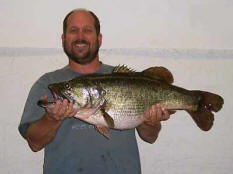

ShareLunker No. 394
Lake Record - Caught by Tom Sutherland of Del Rio, TX
December 28, 2005 in Amistad 15' of water at confluence of Devil's River and Rio Grande 15.68 pounds, length 28.3 inches, girth 21.75 inches Bait/Lure: Norman DD22 Day of Week: Wed Moon Phase: N-2 Type: Florida/northern cross
How to Enter a Lunker
If your fish meets the requirements listed below, call our toll-free, 24-hour pager at 1-888-784-0600 (October 1-April 30 only) or (903) 681-0550.
- The program is limited to largemouth bass weighing 13 pounds or more.
- Entries are accepted October 1 through April 30.
- The fish must be legally caught in Texas waters.
- Fish must be weighed on certified or legal-for-trade scales. Click here for assistance in finding scales, or visit our list of ShareLunker Weigh and Holding Stations. Certified scales are scales that have been certified as accurate by the Texas Department of Agriculture, the International Game Fish Association (IGFA) or a commercial scales calibration company.
- Possession of the fish must be transferred to a designated Texas Parks and Wildlife Department representative within 12 hours after capture. Call TPWD as soon as possible with your name, where the fish is located, a telephone number where you can be reached and when and where you caught the fish. Be sure to include your area code when leaving a message on the pager.
- A TPWD employee will be solely responsible for accepting a fish into the program based on the expectation that the fish will be able to survive and spawn. Fish held at Weigh and Holding Stations are not officially entered into the ShareLunker program until accepted by a TPWD representative.
- The angler must sign a release absolving all sponsors, Texas Parks and Wildlife Department, and Texas Parks and Wildlife Department employees of any liability resulting from the loss or death of the fish.
Benefits of Participation
At the end of spawning season, the ShareLunker will be returned to the angler for live release, or the angler may donate it permanently to the program. Either way, the angler receives a fiberglass replica of the catch made by Lake Fork Taxidermy, ShareLunker clothing, and recognition at an annual awards banquet held at TFFC. In addition, the Texas resident catching the largest entry of the season is awarded a lifetime fishing license.
Tips for Proper Care and Handling of Lunker Bass
-
Land the fish as quickly as possible. Playing a fish to exhaustion diminishes its chance of survival.
-
If possible, refrain from using a dip net that has a mesh larger than ¼ inch and /or is not a smooth mesh. When using a net, always make sure it is wet before it touches the fish.
-
Avoid excessive handling or dropping of the fish while removing the hook. The fish will benefit from remaining in water (boat livewell or a large cooler filled with water) while the hook is removed with needlenosed pliers. Hold the fish vertically by the lower lip while it is in the water so that the total weight of the fish doesn’t rest on the lower jaw.
-
Take the fish to a marina or closest certified scales as soon as possible. Transport the fish in a properly aerated livewell or a large cooler equipped with an aerator.
-
Before removing the fish from the transport container, have the certified scales ready for weighing. Try to arrange to hold the fish in the marina’s minnow vat after it is weighed.
-
To reduce stress when removing the fish from the transport container for weighing, move the fish as close as possible to the scales and holding vat before removal. If everything is ready before the fish is removed from the transport container, weighing time can be less than one minute.
-
It is best to sedate the fish in the transport container before weighing or taking pictures. Marinas and bait shops can supply the recommended chemicals. Wet your hands before handling the fish. Lift the fish from the water vertically by clamping your thumb on the bottom lip. To raise the fish into a horizontal position, support the fish’s weight by placing your off-hand under the fish just behind the anal fin. This method should also be used if the fish is not sedated. Don’t roll back the lip in an effort to paralyze the fish. This can damage the lower jaw and hinder or prevent the fish from feeding after being released. The fish should not be out of the water longer than 30 seconds. Persons taking pictures should have their cameras ready before the fish is removed from the holding container. Holding the fish out of the water two to three minutes, or holding it in a plastic bag without proper aeration, causes stress that can damage the eyes or cause a bacterial and/or fungal infection. Such damage could cause mortality even several weeks later. Note that stress is increased by extremes in temperatures and/or windy weather conditions.
-
Ideal water temperature for holding fish is 55 to 75 degrees Fahrenheit, and the water temperature should not be changed more than five or six degrees per hour. If water is aerated and treated with bacterial/fungal retardant, low water temperature may not be crucial.
-
Call Texas Parks and Wildlife Department as soon as possible with your name, where the fish is located, a telephone number where you can be reached and when and where you caught the fish. Be sure to include your area code when leaving a message on the pager. Every attempt will be made to collect the fish within 12 hours, sooner if possible.
-
To request pickup of a ShareLunker (largemouth bass 13 pounds or over, legally caught in Texas waters between October 1 and April 30), call (903) 681-0550 or page 1 (888) 784-0600 and leave a number, including area code.
Official Weigh and Holding Stations
TPWD employees will travel anywhere in the state to retrieve a big bass. The goal is to provide the fish with expert care within 12 hours of being caught.
Texas is a big state, however, and we occasionally have more than one lunker waiting to be picked up. To keep those big bass healthy, TPWD is working with local fishing businesses and tackle shops to provide temporary holding stations for anglers who wish to donate fish to the program.
A list of holding stations is provided below. Stations are needed at other lakes, especially those located far from Athens. Any business interested in becoming an official ShareLunker Weigh and Holding Station should contact Juan Martinez at (903) 670-2285.
Lake Amistad
Angler’s Lodge
8969 W. US 90
Del Rio, Texas
www.theanglerslodge.com
(830)719-9907
Choke Canyon
Calliham Store
201 Recreation Road #8
Calliham, Texas 78007
(361)786-2685
Lake Conroe
Stow-A-Way Marina & RV
Park
13988 Calvary Road
Willis, Texas 77318
(936)856-4531
Lake Fork
Lake Fork Marina
275 County Road 1558
Alba, TX 75410
(903)765-2764
www.lakeforkmarina.com
Minnow Bucket Marina
3035 W State Highway 154
Quitman, TX 75783
(903)878-2500
O.H. Ivie Reservoir
Concho Park Marina
24282 CR 4763
Millersview, TX, 76862
(915)357-4466
Elm Creek Marina
457 Recreation Road 10
Voss, TX 76888
(325)357-4776
Lake Raven
Huntsville State Park
(936)295-5644
Sam Rayburn Reservoir
Jackson Hill Park
Marina
1705 FM 2851
Broaddus, Texas 75929
(936)872-9266
Background
The roots of the ShareLunker program can be traced to the drought of the 1950s. That 10-year dry spell brought home to Texans the fact that the state’s burgeoning population had outgrown its water supply. A few reservoirs had been built previously, but the 1960s and 1970s witnessed the completion of many more. Texas had only one natural lake — Caddo — and the native species of Texas bass, the northern, was adapted to live in streams.
Fish adapted to live in large lakes were needed to take advantage of the new reservoirs, and in 1971 TPWD brought the first Florida strain largemouth bass to Texas. They were housed at the Tyler Fish Hatchery (now closed), and the first Florida strain bass were stocked into Texas waters the following year.
Over the next several years bass from Florida, California and Cuba were brought to Texas to improve the genetics of the Texas bass population. The Cuban fish were obtained by sheer daring. Joe Bob Wells, a Levelland resident who fished in Cuba frequently, flew to Cuba in December 1984 and brought bass back to Texas via Mexico, since travel between the United States and Cuba was prohibited.
As the Florida strain genes worked their way into the bass population, fish grew bigger. In 1980 a 14.1-pound bass broke the state record of 13.5 pounds that had stood for 43 years. The record increased again and again, to the current 18.18-pound fish caught in 1992. Interest in bass fishing burgeoned along with the size of the fish.
History
The Toyota ShareLunker Program (formerly called Operation Share a Lone Star Lunker and sponsored by the Lone Star Brewing Company, Jungle Labs and Cajun Boats) was established in 1986 to promote catch-and-release of large fish and to selectively breed trophy largemouth bass. The first fish entered into the program was also a new state record, a 17.67-pounder caught from Lake Fork in November.
In 1993 the name of the program was changed to Share a Lunker, Inc., and it was merged with the Parks and Wildlife Foundation of Texas. Anheuser Busch was the official sponsor from 1996 to 2008, providing prizes for anglers and a specially equipped truck used to pick up and return lunkers. During that time the program was known as the Budweiser ShareLunker Program. The name was changed to the Toyota ShareLunker Program in 2009 when Toyota became the new sponsor.
Since the program’s inception, more than 400 largemouth bass have been donated from 55 public reservoirs and more than a dozen private lakes.
The House that Big Bass Built
As the program grew, it became obvious that the Tyler hatchery was inadequate, but there was no state money available to build a new hatchery, one tailored specifically to the needs of the program. It was decided to let cities bid to become the site and help raise the money for it.
Specifications called for the facility to be built within 50 miles of Lake Fork, because the majority of big fish are caught there. The Athens community pledged more than $4 million to win the bidding for the site, and the balance of the cost came from federal Sport Fish and Wildlife Restoration funds and donations. No state money was used for construction.
The Edwin L. Cox, Jr., Texas Freshwater Fisheries Center was built around the ShareLunker program. The Visitor Center complex, including the Lunker Bunker, was completed in 1996, and the exterior hatchery ponds went into operation in 1998.
Accomplishments
The ShareLunker program has been instrumental in illustrating the importance of catch and release fishing in the development of trophy largemouth bass fisheries. Data collected by the program shows that it takes 8 to 10 years for a bass to grow to 13-pound size. Slot limits that protect large fish have been proven effective in increasing the quality of fishing. Science-based fisheries management has been shown to be the best method for managing Texas public waters.
Bass fishing has enjoyed an increase in popularity in Texas that parallels the increase in the number and quality of fish in Texas reservoirs. Communities near popular bass fishing lakes reap a significant economic boost from anglers.
Even the fish have benefited from the ShareLunker program. When the program began, little was known about the procedures needed to care for big bass. Early in the program, many entries died while at TPWD facilities. Over time better care has increased survival to the point that nearly all fish entered into the program survive to be used for spawning or are returned to the wild. Even more importantly, proper fish handling techniques have been publicized as part of the program, so that anglers are now able to take better care of any fish they catch.
In the course of caring for more than 500 largemouth bass weighing over 13 pounds, the ShareLunker Program has:
-
improved knowledge of proper handling and care of big fish
-
developed and communicated to anglers recommendations for handling fish in ways that improve survival
-
established weigh and holding stations at major reservoirs around the state to improve the survival of big fish by providing the proper environment for them until pickup by trained TPWD personnel
-
generated nationwide interest in Texas bass fishing and increased tourism, as evidenced by 82 ShareLunkers having been caught by residents of 22 states other than Texas
-
documented the number of lakes producing 13-pound or larger bass from one in 1980 to 62 by 2011
-
created awareness of the value of catch-and-release fishing
-
developed a selective breeding program that produces broodfish used throughout the TPWD hatchery system, helping spread ShareLunker-derived genetics to all public waters stocked with Florida largemouth bass by TPWD
-
generated free publicity for bass fishing in Texas worth millions of dollars by providing the basis for thousands of newspaper, magazine, television, radio and electronic media stories
-
provided funding to develop cutting-edge genetic fingerprinting techniques that makes it possible for TPWD to identify ShareLunkers and their offspring stocked into public waters. These techniques also make possible:
-
genetic identification using a minimally invasive fin clip;
-
positive identification of ShareLunker offspring and confirmation of previously caught ShareLunkers should implanted tags be unreadable;
-
more accurate identification of intergrades (crosses between Florida and northern largemouths) and easier determination of parentage and relatedness among ShareLunkers, including identification of sisters submitted to the ShareLunker program;
-
genetic analysis of scale samples archived from ShareLunkers submitted to the program before the DNA fingerprinting techniques were available;
-
the search for genetic markers associated with ShareLunkers and for gender determination. Samples are being analyzed in an attempt to determine if there is a specific gene that influences growth differences.
Using genetic fingerprinting techniques developed in the last five years, TPWD has begun studies in selected public reservoirs using tagged ShareLunker offspring (referred to as Operation World Record or OWR fish) to determine the growth rate of OWR fish compared to other largemouth bas in those reservoirs. Results so far show OWR fish grow bigger faster.
These accomplishments have all been made using program sponsor dollars and without additional staff over and above those required for normal operation.
Frequently Asked Questions
- What is the mission of the ShareLunker Program?
- To involve the public in the conservation and enhancement of trophy bass fishing in Texas.
- Why does TPWD want anglers to donate fish?
- Donating your fish
helps TPWD:
- Promote catch and release to conserve Texas’s bass populations;
- Increase public awareness of trophy bass angling opportunities to grow the sport of angling;
- Obtain catch and genetics information to better understand and manage Texas’s trophy bass; and
- Perform selective breeding of trophy bass to improve growth and maximum size potential.
- What is Operation World Record?
- Operation World Record (OWR) is an ongoing research project to evaluate the selective breeding portion of the ShareLunker Program. In the first segment of this project ShareLunker offspring were raised to 6 inches, tagged and stocked into six public reservoirs and a few small private water bodies to compare growth at age 4 to resident bass in each lake. Private lakes were used to control fishing pressure and protect the fish until they reach trophy size. Currently, another study is underway to compare ShareLunker offspring growth to that of our traditional Florida bass fingerlings.
- Where are ShareLunkers taken?
- Most donated fish go to the Texas Freshwater Fisheries Center (TFFC) in Athens. This state-of-the-art fish-care facility opened in 1996 and contains special tanks and fish care facilities known as the “Lunker Bunker” as well as experienced personnel to care for large bass. Some lunkers from the southern parts of Texas go to the A.E. Wood Hatchery in San Marcos, where they are held until completion of a DNA test. If they are not 100 percent Florida largemouth bass, they go back to the angler and are restocked into the capture lake. If they are 100 percent Florida, they go to TFFC for spawning.
- How many ShareLunkers have died while in the care of TPWD?
- Overall since the start of the program through the end of 2011, 144 of the 523 donated fish have died after being transferred to TPWD (72% survival rate). There has been a gradual improvement over time as we have learned more about care of these fish. In the last three years the survival rate of donated fish has averaged 87 percent.
- Why do some ShareLunkers die?
- Unfortunately, many ShareLunkers are in poor condition when TPWD arrives at the lake. These fish have sometimes been held in a livewell for several hours and have been handled multiple times in addition to the stress of being caught. ShareLunker program survival rates could be increased by: 1) refusing to accept stressed fish, or 2) minimizing handling and livewell exposure time before we can arrive. All accepted ShareLunkers get the best possible care at TFFC, which greatly improves their chance of survival.
- What is being done to improve survival of ShareLunkers?
- Through lessons learned in handling donated ShareLunkers, TPWD has been able to educate both anglers and TPWD staff on the proper care of trophy bass. Anglers today are much more aware of the value of these large bass and how to care for them. Several tournament organizations have changed their rules allowing the early weigh-in of 13-pound fish and are encouraging anglers to bring them to the weigh-in facilities immediately after catch. Additionally, TPWD has certified several lake-based ShareLunker Weigh and Holding Stations.
- What is a ShareLunker Weigh and Holding station?
- These are typically tackle shops or stores in close proximity to reservoirs where anglers can bring potential ShareLunkers for weighing on a certified scale. Holding stations have tanks suitable for temporarily holding ShareLunkers and staff that are experienced in caring for ShareLunkers until pick-up. A list of ShareLunker Weigh and Holding Stations can be found on this website.
- Why are some ShareLunkers returned to their reservoir of origin and not spawned?
- All donated fish are tested to determine their exact genetic make-up. Only fish that test out to be “pure Florida bass” are accepted into the selective breeding program. While we know bass having a combination of northern and Florida bass genes (intergrades) can reach large size, the majority of the donated ShareLunkers are pure Florida bass. By limiting the selective breeding program to those fish, we are able to cross pure Florida bass females over 13 pounds with pure Florida bass males which are offspring of previous ShareLunkers, increasing the odds of superior genetics and potential for achieving maximum size. All fish that are not accepted into the breeding program are returned to the lake of origin as soon as they have fully recovered from the initial trip, if that is the desire of the angler who donated the fish.
- How many of the ShareLunkers successfully spawn in the hatchery?
- Not all ShareLunkers successfully spawn in the hatchery. Sometimes late-season entries from southern reservoirs have already spawned. During the last four years, 41 ShareLunkers have been paired, and 15 of these spawned (37 percent). Most of these fish spawned more than once while at the hatchery.
- Who decides whether or not a ShareLunker is returned, and are they always returned to the reservoir of origin?
- A ShareLunker is the property of the angler who caught it. Most choose to release the fish back into the reservoir from which it was caught. In a few cases, anglers have chosen to release the fish into a different reservoir. Some anglers have permanently donated their fish to TPWD so it can be used in future years for selective breeding.
- How can I find out the status of a donated fish?
- The information on the status of each fish can be found by searching the archives on our website. There you can find out if the fish died, its genetic make-up, if the fish spawned, and when it was returned to the lake. Similar information is being added for previous ShareLunkers as time allows.
- If a 13-pound fish is returned to the lake instead of loaned to the program, how many offspring will it produce in the wild?
- A typical female largemouth bass produces 5,000 to 15,000 fertilized eggs. This is similar for fish that successfully spawn in the hatchery and in the wild.
- If a ShareLunker successfully spawns in the hatchery, how many of its offspring survive after being stocked into Texas reservoirs?
- Less than 10 percent of largemouth bass offspring produced in the wild survive to be 1 inch long because of predation and unfavorable environmental conditions. While TPWD has no data on how many hatchery-reared fish survive after being stocked, the presence of a strong Florida largemouth bass influence in reservoirs statewide proves that stocking works.
- What is selective breeding?
- Selective breeding is the intentional breeding of organisms with a desirable trait in an attempt to produce offspring with a similar desirable trait. In the case of ShareLunker we are attempting to produce offspring with traits of fast growth rates and greater maximum body size.
- What is the origin of the male paired with a ShareLunker?
- The males that are paired with ShareLunker females are the offspring of previous ShareLunkers.
- How many ShareLunker offspring are produced?
- A little over 575,000 ShareLunker offspring were produced from 2005 to 2011. Annual production ranged from a low of about 10,000 in 2007 to a high of 175,000 in 2011.
- Where are ShareLunker offspring stocked?
- From 2005 to 2011,
the vast majority of offspring (96 percent)
were stocked into public water bodies.
Allocation of these offspring was:
- Public reservoirs for OWR research (15 percent)
- Private reservoirs for OWR research (4 percent)
- Public reservoirs for management (81 percent)
- Does removing a few 13-pound fish from a reservoir reduce a reservoir’s ability to produce trophy fish in the future?
- We feel that the impact is minimal. Many ShareLunkers are returned to the producing reservoir. Also, by the time they’ve reached 13 pounds they have spawned multiple times, insuring that their genetic traits have already been passed to new generations. In addition, reservoirs that contribute ShareLunkers are supplementally stocked with selectively bred ShareLunker offspring that may have improved genetic traits over what is produced in the wild.
- Why do some Texas waters receive stockings of ShareLunker offspring and others do not?
- The primary destinations are research lakes or lakes which have produced ShareLunkers in the past. In most years, all lakes producing a ShareLunker get a stocking even if the ShareLunker from a particular lake did not produce offspring or have the appropriate genetic make-up for inclusion in the selective breeding program. Fingerlings have also been stocked in new or recently filled lakes that have good trophy potential to give us the unique opportunity to track their impacts (examples: Lake Naconiche and Lake Sweetwater). A list of public waters receiving stockings of ShareLunker fingerlings can be found via our stocking reports.
- What is the difference between Northern bass, Florida bass and ShareLunker offspring?
- Northern bass offspring are fingerlings from the subspecies of largemouth bass that is native to Texas.
- Florida bass offspring are fingerlings from the subspecies that is native to the Florida peninsula and were introduced to Texas in the early 1970s. Florida bass have demonstrated the potential to grow much larger than Northern bass.
- ShareLunker offspring are selectively bred Florida bass that come from the pairing of a female ShareLunker and a male bass that is the offspring of a previous ShareLunker.
- Do ShareLunker offspring out-perform offspring produced in the wild and pure Florida bass?
- Recent studies showed that ShareLunker offspring stocked into six public reservoirs averaged about one-third pound heavier at age 4 than same-age resident fish, which were mostly intergrades. Studies are currently underway to compare growth of ShareLunker offspring to the pure Florida bass that are normally produced in our fish hatcheries.
- Have ShareLunkers been used as brood fish in production of Florida bass fingerlings?
- ShareLunker offspring are currently being raised to be integrated into our regular Florida bass brood stock. Great care must be used to insure that this is done in a way that maintains a high level of genetic diversity.
- Have any of the donated 13-pound fish come from ShareLunker parents?
- There is currently no definite proof that any ShareLunkers were direct descendants of the ShareLunker parents used in our breeding program. However, recently developed DNA fingerprinting technologies will allow us to track this in the future.
- What are the economic benefits of the ShareLunker program?
- The ShareLunker program has been a vital part of making Texas a bass-fishing destination known around the world. This has a substantial economic impact on communities near trophy bass lakes. For example, a study of the impact of the Lake Fork trophy bass fishery on the local economy showed it to be $27 million annually.
- Do other states have similar programs?
- Several other state fisheries agencies have inquired about Texas’ ShareLunker program, and some initiated similar projects or programs, but on a much smaller scale. The ShareLunker program remains unique to Texas.
- If I catch a ShareLunker, what can I do to give it the best chance of survival?
- Handle the fish as little as possible and get it to a ShareLunker holding station or into a minnow tank as soon as possible after catching it. See tips for care and handling.
- Consider equipping your livewell with an oxygen system.
- Learn how to treat fish for barotrauma. Find instructions at the bottom of this article.
- How can I get more information about the ShareLunker program?
- To find out current events pertaining to the ShareLunker program, visit the
- ShareLunker Facebook page.
To ask questions about or discuss the ShareLunker program, call or write:
Texas Freshwater Fisheries
Center
5550 F.M. 2495
Athens, Texas 75752
(903) 676-BASS (2277)
ShareLunker program
manager:
Juan Martinez
To donate a 13-pound or larger bass to the ShareLunker program:
Call our toll-free, 24-hour pager at
1-888-784-0600 (October
1-April 30 only) or
(903)681-0550.
